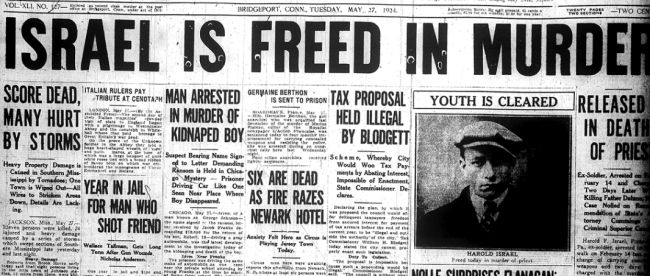The Weekender, December 23, 2016

1) “Homer and Harold” (The Marshall Project, 23 minutes, December 2016). As the sub-head notes, “stories abound of present-day prosecutors who have lost their way, who do anything to win a conviction, who place politics above principle .” This is a fascinating story of the exact opposite. As demonstrated by the pull-quote below, the prosecutor could have easily obtained a conviction against the accused. Instead, the prosecutor investigated further and helped an innocent man go free.
Three weeks after Father Dahme’s death, the coroner summarized the evidence against [Harold] Israel:
A waitress said she had seen Israel walk past her restaurant minutes before the shooting took place a block away.
Four witnesses said they had seen Israel after the shooting, fleeing the scene.A ballistics expert said the bullet recovered from Father Dahme’s head had been fired by the revolver found on Israel.And then there was Israel’s confession, oral and written.
The case against the accused seemed overwhelming.
Upon its face, at least, it seemed like a well-nigh perfect case … The evidence had been described by those who believed in the guilt of the accused as ‘100 percent perfect.’
In 1924, the criminal justice system’s flaws were not understood in the way they are today, now that DNA has exposed so many wrongful convictions. In 1924 there was little written about false confessions, mistaken eyewitnesses, or bogus forensics. The year before Israel’s arrest, Learned Hand, an esteemed federal judge in New York, wrote: “Our procedure has been always haunted by the ghost of the innocent man convicted. It is an unreal dream.”
2) Some Ways to Support Now I Know: Now I Know is supported by readers like you. If you’d like to help, here are some ways how:
- Send me story ideas. Really! I have lots stored up — I won’t run out anytime soon — but things that pique your interest typically make for better stories than what’s in my backlog. Just hit reply to let know of something interesting you’ve come across.
- Please consider becoming a patron by supporting the project on Patreon. Click here to pledge your support.
- If you’re looking for a last minute gift, check out AwesomeClaus (my gift site) or if you’re buying an Amazon gift card, use this link.
- If you’re looking for a good gift for a reader in your life — for Christmas or otherwise — please consider my book and its sequel.
- And most importantly: recommend Now I Know to a friend or, to lots of them! To tell your Facebook friends about Now I Know, just click here, add a personal note, and hit “Post.” Thanks!
3) “The Socialite Spy Who Played So Dumb She Outsmarted the Nazis” (The Daily Beast, 16 minutes, September 2016). This reads like a James Bond plot minus the gadgets and, well, the Bond character. Definitely worth the read. Thanks Jen S. for the tip!
4) “My Life on (Simulated) Mars” (Narratively, TK, April 2016). The sub-head: “This is the true story of six strangers picked to live together in a geodesic dome, on top of a volcano, in a barren atmosphere chosen to replicate life in outer space. ”
Sunday isn’t my day to cook breakfast, so I get to stay in bed for a few minutes longer. Still, there’s no day off on Mars, or on sMars, as we call the simulated Mars-like environment where I am living for a full year. Strapping a grey pedometer around my wrist, I reach for my iPad, then my electronic badge. One by one, I gather up and put on the other various gadgets and gizmos that track my heart rate, location, and distance to other crewmembers as I go about my life, in this simulated world.
By “simulated” I don’t mean to imply that sMars is some kind of virtual-reality game, theme park, or subterranean research facility. It’s quite real – as real as my home back in St. Louis. Only instead of a brick-and-mortar two-story on a tree-lined street, it’s a 1,200-square-foot dome near the top of Mauna Loa volcano in Hawaii. For the past half year, six simulated astronauts, myself included, have been living, working, eating and conducting experiments on everything from plant growth to virtual reality inside this white geodesic frame as if we were on Mars.
WeekenderAdUnits
5) “Robots Say the Darndest Things” (GQ, 19 minutes, March 2011). David Hanson is a world-class designer of humanoid robots. The author got a chance to interview some of Hanson’s creations, including one named Zeno. Here’s some background, from the article. (Thanks to reader Doreen T. for the tip!)
David Hanson is a believer in the tipping-point theory of robot consciousness. Right now, he says, Zeno is “still a long way from human-level intellect, like one to two decades away, at a crude guess. He learns in ways crudely analogous to a child. He maps new facts into a dense network of associations and then treats these as theories that are strengthened or weakened by experience.” Hanson’s plan, he says, is to keep piling more and more information into Zeno until, hopefully, “he may awaken—gaining autonomous, creative, self-reinventing consciousness. At this point, the intelligence will light ‘on fire.’ He may start to evolve spontaneously and unpredictably, producing surprising results, totally self-determined…. We keep tinkering in the quest for the right software formula to light that fire.”
6) “What’s the Hardest Shot in Bowling?” (Slate, 7 minutes, February 2015). Slate obtained access to a data set of more than 400,000 bowling frames from the Professional Bowlers Association and figured out which second-ball pin settings were the hardest to convert into spares. The 7-10 split isn’t the hardest — that goes to something called “the Greek Church,” and you’ll have to click through to see what that is. Another surprise: of the frames analyzed, nearly 60% were strikes.
Have a great weekend, and Merry Christmas and Happy Hannukah to those who celebrate!

